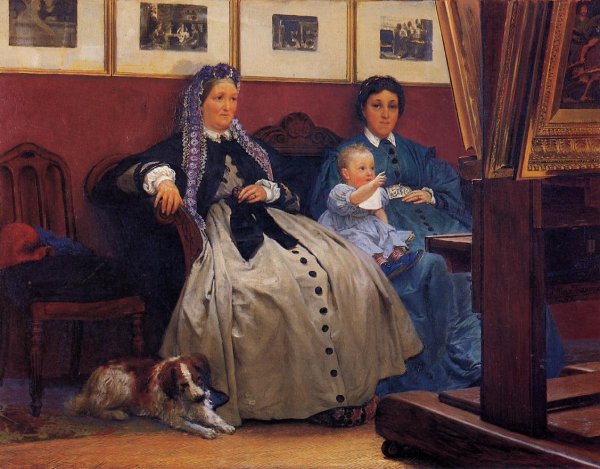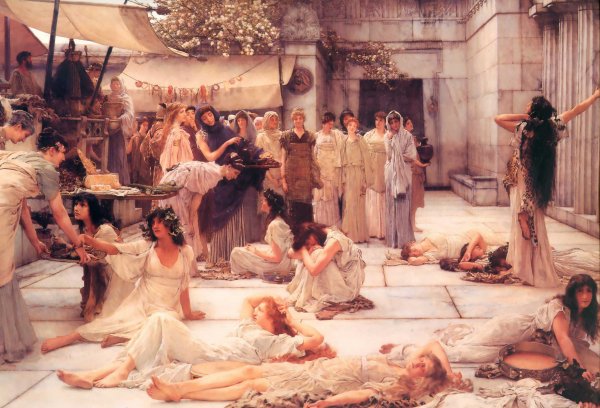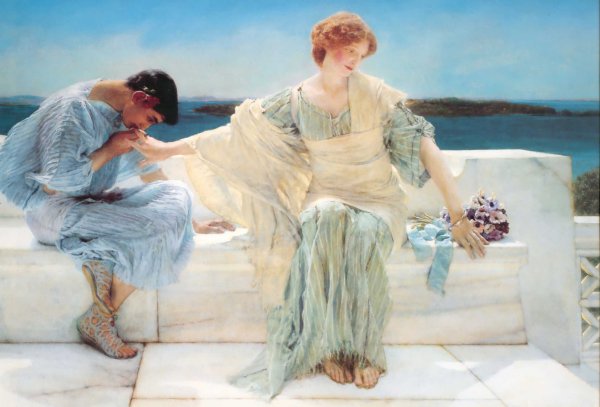Sir Lawrence Alma-Tadema Biography In Details
Early life

Sir Lawrence Alma-Tadema was born as Laurens Tadema on January 8, 1836, in the small village of Dronrijp, in Friesland in the north of the Netherlands. He was the sixth child of Pieter Jiltes Tadema (1797-1840), the village notary, who had had three sons by a previous marriage, and the third child of his mother, Hinke Dirks Brouwer (c. 1800-1863). Hinke Brouwer was the half sister of Pieter Tadema's first wife. Her first child died early and the second was Atje (c.1834-c. 1876), Laurence' sister, for whom he had great affection. Tadema, (meaning Adam-son), was an old Frisian patronymic ending with the suffix 'ma' - 'son of' while the names Laurens and Alma belonged to the boy's godfather. Laurens would later changed his name to the more English Lawrence, and incorporated Alma into his surname in order to have his name appear at the beginning of exhibition catalogues, under A rather than under T. He did not actually hyphenate his last name, but it was done by others and this has since become the convention.
The Tadema family moved in 1838 to the near town of Leeuwarden, where Pieter's position as a notary would be more lucrative. His father died when Laurens was four, leaving his mother with five children: Laurens, his sister, and three boys from his father's first marriage. His mother had artistic leanings, and decided that drawing lessons should be incorporated into the children's education. He received his first art training with a local drawing master hired to teach his older half-brothers.
It was intended that the boy would become a lawyer; but in 1851 at the age of fifteen he suffered a physical and mental breakdown. Diagnosed as consumptive; given only a short time to live, he was allowed to spend his remaining days at his leisure, drawing and painting. Left to his own devices he regained his health and decided to pursue a career as an artist. In 1852 he entered The Royal Academy of Antwerp where he studied early Dutch and Flemish art, under Egide Charles Gustave Wappers. During Alma-Tadema's four years as a registered student at the Academy, he won several respectable awards.
Before leaving school, towards the end of 1855, he became assistant to the painter and professor Louis (Lodewijk) Jan de Taeye, whose courses in history and historical costume he had greatly enjoyed at the Academy. Although de Taeye was not an outstanding painter, Alma-Tadema respected him and became his studio assistant working with him for three years. De Taeye introduced him to books that influenced his desire to portray Merovingian subjects early in his career. He was encouraged to depict historic accuracy in his paintings, a trait for which the artist became known. Alma-Tadema left Taeye's studio in November 1858 returning to Leeuwarden before settling in Antwerp, where he began working with the painter Baron Jan August Hendrik Leys, whose studio was one of the most highly regarded in Belgium. Under his guidance Alma-Tadema painted his first major work: The Education of the children of Clovis (1861). This painting created a sensation among critics and artists when it was exhibited that year at the Artistic Congress in Antwerp. It is said to have laid the foundation of his fame and reputation. Alma-Tadema related that although Leys thought the completed painting better than he had expected, he was critical of the treatment of marble, which he compared to cheese. Alma-Tadema took this criticism very seriously, and it led him to improve his technique and to become the world's foremost painter of marble and variegated granite. Despite any reproaches from his master, The Education of the Children of Clovis was honorably received by critics and artists alike and was eventually purchased and subsequently given to King Leopold of Belgium.
Early works

Merovingian themes were the painter's favorite subject up to the mid-1860's. It is perhaps in this series that we find the artist moved by the deepest feeling and the strongest spirit of romance. However Merovingian subjects did not have a wide international appeal, so he switched to themes of life in ancient Egypt that were more popular. On these scenes of Frankish and Egyptian life Alma-Tadema spent great energy and much research. In 1862 Alma-Tadema left Leys's studio and started his own career, establishing himself as a significant classical-subject European artist.
1863 was to alter the course of Alma-Tadema's personal and professional life: on January 3 his invalid mother died, and on September 24 he was married, in Antwerp City Hall, to Marie-Pauline Gressin, the daughter of Eugene Gressin, a French journalist of royal descent living near Brussels. Nothing is known of their meeting and little of Pauline herself, as Alma-Tadema never spoke about her after her death in 1869. Her image appears in a number of oils, though he painted her portrait only three times, the most notable appearing in My studio (1867). The couple had three children. Their eldest and only son lived only a few months dying of smallpox. Their two daughters, Laurence (1864-1940) and Anna (1867-1943), both had artistic leanings: the former in literature, the latter in art. Neither would marry.
Alma-Tadema and his wife spent their honeymoon in Florence, Rome, Naples and Pompeii. This, his first visit to Italy, developed his interest in depicting the life of ancient Greece and Rome, especially the latter since he found new inspiration in the ruins of Pompeii, which fascinated him and would inspire much of his work in the coming decades.
During the summer of 1864, Tadema met Ernest Gambart, the most influential art dealer and impresario of the nineteenth century. Gambart was highly impressed with the work of Tadema, who was then painting: Egyptian chess players (1865). The dealer recognizing at once the unusual gifts of the young painter: he gave him an order for twenty-four pictures and arranged for three of Tadema's paintings to be shown in London. In 1865, Tadema relocated to Brussels where he was named a knight of the Order of Leopold I.
On May 28 1869, after years of ill health, Pauline died at Schaerbeek, in Belgium, at the age of thirty-two, of smallpox. Her death left Tadema disconsolate and depressed. He ceased painting for nearly four months. His sister Artje, who lived with the family, helped with the two daughters then aged five and two. Artje took over the role of housekeeper and remained with the family until 1873 when she married.
During the summer Tadema himself began to suffer from a medical problem which doctors in Brussels were frustratingly unable to diagnose. Gambart eventually advised him to go to England for another medical opinion. Soon after his arrival in London in December 1869, Alma-Tadema was invited to the home of the painter Ford Madox Brown. There he met the seventeen years old Laura Theresa Epps and fell in love with her at first sight.
Move to England

The outbreak of the Franco Prussian War in July 1870 compelled Alma-Tadema to leave the continent and move to London. His infatuation with Laura Epps played a great part in his relocation to England and Gambart felt that the move would be advantageous to the artist's career. In stating his reasons for the move, Tadema simply said: "I lost my first wife, a French lady with whom I married in 1863, in 1869. Having always had a great predilection for London, the only place where, up till then my work had met with buyers, I decided to leave the continent and go to settle in England, where I have found a true home."
With his small daughters and sister Artje, Alma-Tadema arrived in London at the beginning of September 1870. The painter wasted no time in contacting Laura, and it was arranged that he would give her painting lessons. During one of these, he proposed marriage. As he was then thirty-four and Laura was now only eighteen, her father was initially opposed to the idea. Dr Epps finally agreed on the condition that they should wait until they knew each other better. They married in July 1871. Laura, under her married name, also won a high reputation as an artist, and appears in numerous of Alma-Tadema's canvases after their marriage (The Women of Amphissa (1887) being a notable example). This second marriage was enduring and happy, though childless, and Laura became stepmother to Anna and Laurence.
Victorian painter

After his arrival in England, where he was to spend the rest of his life, Alma-Tadema's career was one of continued success. He became one of the most famous and highly paid artists of his time, acknowledged and rewarded. By 1871 he had met and befriended most of the major Pre-Raphaelite painters and it was in part due to their influence that the artist brightened his palette, varied his hues, and lightened his brushwork.
In 1872 Alma-Tadema organized his paintings into an identification system by including an opus number under his signature and assigning his earlier pictures numbers as well. Portrait of my sister, Artje, painted in 1851, is numbered opus I, while two months before his death he completed Preparations in the Coliseum, opus CCCCVIII. Such a system would make it difficult for fakes to be passed off as originals.
In 1873 Alma-Tadema became the last denizen, with limited rights short of citizenship. The previous year he and his wife made a journey on the Continent that lasted five and a half months and took them through Brussels, Germany, and Italy. In Italy they were able to take-in the ancient ruins again; this time he purchased several photographs, mostly of the ruins, which began his immense collection of folios with archival material sufficient for the documentation used in the completion of future paintings. In January 1876, he rented a studio in Rome. The family returned to London in April, visiting the Parisian Salon on their way back.
Among the most important of his pictures during this period was An Audience at Agrippa's (1876). When an admirer of the painting offered to pay a substantial sum for a painting with a similar theme, Alma-Tadema simply turned the emperor around to show him leaving in After the Audience.
On June 19, 1879, Alma-Tadema was made a full Academician, his most personally important award. Three years later a major retrospective of his entire oeuvre was organized at the Grosvenor Gallery in London, including 185 of his pictures. Unconscious Rivals, (1893), oil on panel,45 x 63 cm, Bristol City Museum and Art Gallery. Alma-Tadema's female figures have a slightly bored pleasure seeking attitude, as if they were pampered courtesans.. There is little action in Alma-Tadema's paintings, here the two women are just probably waiting for a lover. The composition is balanced by the flowers in bloom.
In 1883 he returned to Rome and, most notably, Pompeii, where further excavations had taken place since his last visit. He spent a significant amount of time studying the site, going there daily. These excursions gave him an ample source of subject matter as he began to further his knowledge of daily Roman life. At times, however, he integrated so many objects into his paintings that some said they resembled museum catalogues.
One of his most famous paintings is The Roses of Heliogabalus (1888) - based on an episode from the life of the infamously debauched Roman Emperor Elagabalus (Heliogabalus), the painting depicts the psychopathic Emperor suffocating his guest at an orgy under a cascade of rose petals. The blossoms depicted were sent weekly to the artist's London studio from the Riviera for four months during the winter of 1887 - 1888.
Among Alma-Tadema's works of this period are: An Earthly Paradise (1891), Unconscious Rivals (1893) Spring (1894), The Coliseum (1896) and The Baths of Caracalla (1899). Although Alma-Tadema's fame rests on his paintings set in Antiquity, he also painted portraits, landscapes and watercolors, and made some etchings himself (although many more were made of his paintings by others).
Personality
For all the quiet charm and erudition of his paintings, Alma-Tadema himself preserved a youthful sense of mischief. He was childlike in his practical jokes and in his sudden bursts of bad temper, which could as suddenly subside into a most engaging smile.
In his personal life, Alma-Tadema was an extrovert and had a remarkably warm personality. He had most of the characteristics of a child, coupled with the admirable traits of a consummate professional. A perfectionist, he remained in all respects a diligent, if somewhat obsessive and pedantic worker. He was an excellent businessman, and one of the wealthiest artists of the nineteenth century. Alma-Tadema was as firm in money matters as he was with the quality of his work.
As a man, Lawrence Alma-Tadema was a robust, fun loving and rather portly gentleman. There was not a hint of the delicate artist about him; he was a cheerful lover of wine, women and parties.
Last years

Alma-Tadema's output decreased with time, due in part to ill health but also to his obsession for decorating his new home where he moved in 1883. Nevertheless, he continued to exhibit throughout the 1880s and into the next decade, receiving a plentiful amount of accolades along the way, including the medal of Honor at the Paris Exposition Universelle of 1889, election to an honorary member of the Oxford University Dramatic Society in 1890, the Great Gold Medal at the International Fine Arts Exposition in Brussels of 1897. In 1899 he was Knighted in England, only the eighth artist from the Continent to receive the honor. Not only did he assist with the organization of the British section at the 1900 Exposition Universelle in Paris, he also exhibited two works that earned him the Grand Prix Diploma. He also assisted with the St. Louis World's Fair of 1904 where he was well represented and received.
During this time, Alma-Tadema was very active with theater design and production, designing many costumes. He also spread his artistic boundaries and began to design furniture, often modeled after Pompeian or Egyptian motifs, illustrations, textiles, and frame making. His diverse interests highlight his immense talents. Each of these exploits were used in his paintings, as he often incorporated some of his designed furniture into the composition, and must have used many of his own designs for the clothing of his female subjects. Through his last period of creativity Alma-Tadema continued to produce paintings, which repeat the successful formula of women in marble terraces overlooking the sea such as in Silver Favorites (1903). Between 1906 and his death six years later, Alma-Tadema painted less but still produced ambitions paintings like The Finding of Moses (1904).
On 15 August 1909 Alma-Tadema's wife, Laura, died at the age of fifty-seven. The grief-stricken widower outlived his second wife for less than three years. His last major composition was Preparation in the Coliseum (1912). In the summer of 1912, Alma Tadema was accompanied by his daughter Anna to Kaiserhof Spa, Wiesbaden, Germany where he was to undergo treatment for ulceration of the stomach. He died there on June 28, 1912 at the age of seventy-six. He was buried in a crypt in St. Paul's cathedral in London. (From Wikipedia)




